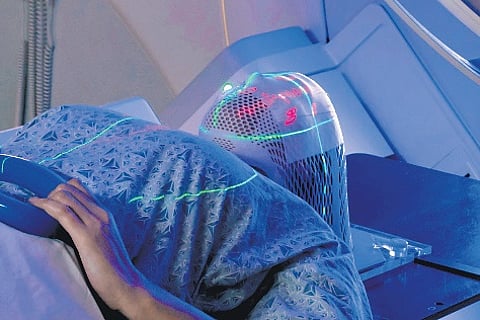

Cancer continues to pose a significant global health challenge, with millions of lives affected by its impact each year. Despite India witnessing a staggering 28% increase in its cancer burden over the past two decades, accessibility to cancer care remains a significant challenge, exacerbated by issues of advanced-stage diagnosis. Amidst these challenges, radiation therapy continues to be one of the more effective options to treat cancer. Navigating radiation therapy can be a daunting prospect for cancer patients. However, understanding the treatment process is vital for patients, as it can help ease the anxiety.
What is radiation therapy?
Radiation therapy, also known as radiotherapy, is a well-established standard treatment modality for various types of cancer. It involves using precisely focused high-energy radiation beams to target and destroy cancer cells while minimising damage to surrounding healthy tissue. It can be used by itself as the only treatment or in combination with surgery, chemotherapy, or both. Sometimes radiation is used to shrink a tumour before surgery (neoadjuvant therapy) or given after surgery to halt the growth of remaining cancer cells (adjuvant therapy). Radiation may also be combined with chemotherapy (chemoradiation) to destroy cancer cells. In people with advanced cancer, radiation may be used to reduce suffering brought on by the disease.
A step-by-step approach
The journey starts with a consultation with a radiation oncologist, who reviews your medical history, conducts a physical examination and discusses treatment options and goals. Following the initial consultation, patients undergo a simulation process to precisely plan their radiation treatment which involves imaging scans, such as CT or MRI, to map out the treatment area and formulate a tailored treatment plan. Techniques such as skin markings, masks or specialised positioning aids ensure accurate targeting of the cancerous tissue while minimising exposure to healthy organs.
Types of radiation therapy
Radiation therapy can be delivered in a variety of forms depending on the type of cancer, the location of the tumour, and whether it has spread. External-beam radiation therapy is the most common form of the treatment. It is applied to the body by a machine, most often in the form of x-rays but sometimes as charged particles called protons or other types of energy. Radiation therapy can also be delivered internally by placing radioactive material in the body near tumours (called brachytherapy). Examples of radiotherapy:
Intraoperative radiation therapy: Delivers radiation during surgery directly to a tumour, allowing surgeons to protect nearby healthy tissue. It can use externalbeam or internal radiation therapy, offering higher doses to the tumour while sparing surrounding healthy tissues.
Image-guided radiation therapy: Uses advanced imaging to pinpoint patient and tumour positions for treatment, without anaesthesia and with fewer side effects. It treats various cancers, including those in the spine, lung, prostate, brain, bladder, oesophagus, liver, and bone, with precise targeting using PET simulator technology to spare healthy tissue.
Intensity-Modulated Radiation Therapy: Delivers potent radiation to tumours while sparing healthy tissues, enhancing the chances of a cure, and reducing side effects. Using CT scans to map tumours, IMRT calculates and administers radiation from multiple angles. It treats various cancers including prostate, head and neck, lung, brain, liver, breast, lymphoma, sarcoma, and some paediatric cancers.
Stereotactic Body Radiation Therapy: This is an advanced technique that delivers highly focused doses of radiation to target cancer cells with remarkable precision. This method utilises sophisticated imaging technology to precisely locate the three-dimensional position of the tumour. By pinpointing the tumour’s exact location, the radiation is accurately directed at cancerous cells, maximising its effectiveness while minimising side effects on nearby healthy tissues.
Proton Therapy: Proton therapy delivers high radiation doses to resistant tumours while protecting nearby tissues. Unlike traditional radiation using X-rays, proton therapy targets tumours with charged particles called protons, reducing side effects.
Internal Radiation Therapy (Brachytherapy): Brachytherapy places tiny radioactive seeds into or around the cancer, delivering radiation directly to the area. Seeds emit radiation mostly around the implant and can be permanent or temporary, often requiring hospitalisation. Temporary implants emit radiation for a few minutes, with precautions taken to minimise exposure to others.
From the initial consultation to the intricacies of treatment planning and the various modalities available, patients are guided through a step-by-step process designed to target cancer cells while minimising damage to healthy tissue. As patients undergo radiation treatment, they may experience various side effects, including fatigue, skin irritation and changes in appetite.
However, these side effects are often manageable and patients are encouraged to communicate openly with their healthcare team. Regular monitoring and follow-up appointments ensure that any concerns or symptoms are addressed promptly, optimising the treatment experience. With advancements in technology and techniques, radiation therapy continues to evolve, providing patients with more precise and effective treatment options.
(The author, Dr. Varadarajan Senthil Kumar, is chief medical oncologist at the India Centre of Memorial Sloan Kettering Cancer Center)